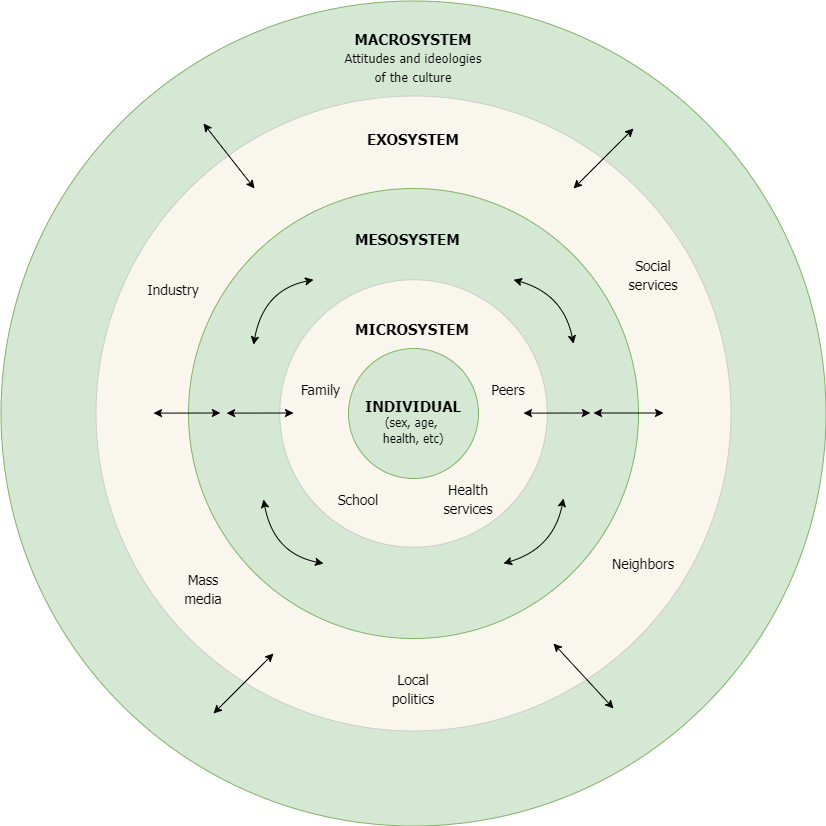Appendix A: Major Perspectives
Ecological Perspective: Bronfenbrenner
Sonja Ann Miller; Lumen Learning; Laura Overstreet; and Diana Lang
- Explain Bronfenbrenner’s bioecological model
Ecological Perspective: Bronfenbrenner’s Ecological Systems Theory
Another psychologist who recognized the importance of the environment on development was American psychologist Urie Bronfenbrenner (1917-2005), who formulated the ecological systems theory (Figure 1) to explain how the inherent qualities of a child and their environment interact to influence how they will grow and develop.
The term “ecological” refers to a natural environment; human development is understood through this model as a long-lasting transformation in the way one perceives and deals with the environment. Bronfenbrenner’s ecological theory stresses the importance of studying children in the context of multiple environments because children typically find themselves enmeshed simultaneously in different ecosystems. Each system inevitably interacts with and influences each other in every aspect of the child’s life, from the most intimate level to the broadest. Furthermore, he eventually renamed his theory the bioecological model in order to recognize the importance of biological processes in development. However, he only recognized biology as producing a person’s potential, with this potential being realized or not via environmental and social forces.
An individual is impacted by microsystems such as parents or siblings, those who have direct, significant contact with the person. The input of those people is modified by the cognitive and biological state of the individual as well. These influence the person’s actions, which in turn influence the systems operating on them.
The mesosystem includes larger organizational structures such as school, family, or religion. These institutions impact the microsystems just described. For example, the religious teachings and traditions of a family may create a climate that makes the family feel stigmatized, and this indirectly impacts the child’s view of their self and others. The philosophy of the school system, daily routine, assessment methods, and other characteristics can affect the child’s self-image, growth, sense of accomplishment, and schedule, thereby impacting the child physically, cognitively, and emotionally.
These mesosystems both influence and are influenced by the larger contexts of the community, referred to as the exosystem. A community’s values, history, and economy can impact the organizational structures it houses.
The community is influenced by macrosystems, which are cultural elements such as global economic conditions, war, technological trends, values, philosophies, and a society’s responses to the global community. In sum, a child’s experiences are shaped by larger forces such as the family, school, religion, and culture.
All of this occurs within the relevant historical context and timeframe, or chronosystem. The chronosystem consists of the environmental events and transitions that occur throughout a child’s life, including any socio-historical events.

This short video from Professor Rachelle Tannenbaum of Anne Arundel Community College explains and gives examples of Brofenbrenner’s theory.
You can view the transcript for “Bronfenbrenner’s ecological theory” here (opens in new window).
Try It
- bioecological model: the perspective suggesting that multiple levels of the environment interact with biological potential to influence development
- chronosystem: the environmental events and transitions that occur throughout a child’s life, including any socio-historical events
- contextual perspective: a theory that considers the relationship between individuals and their physical, cognitive, and social worlds
- ecological systems theory: Urie Bronfenbrenner’s theory stressing the importance of studying a child in the context of multiple environments, organized into five levels of external influence: microsystem, mesosystem, exosystem, macrosystem, and chronosystem
- ecosystem: the larger contexts of the community, including the values, history, and economy
- macrosystem: cultural elements such as global economic conditions, war, technological trends, values, philosophies, and a society’s responses to the global community, which impact a community
- mesosystem: larger organizational structures such as school, the family, or religion
- microsystem: immediate surroundings including those who have direct, significant contact with the person, such as parents or siblings
Attribution
This chapter was adapted from Lumen Learning’s Lifespan Development, developed by Sonja Ann Miller and Laura Overstreet and available under a Creative Commons Attribution-ShareAlike license.
